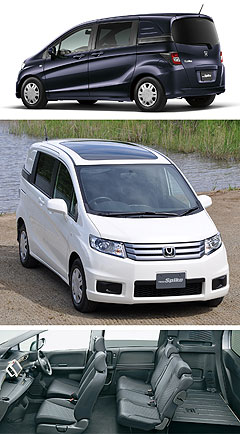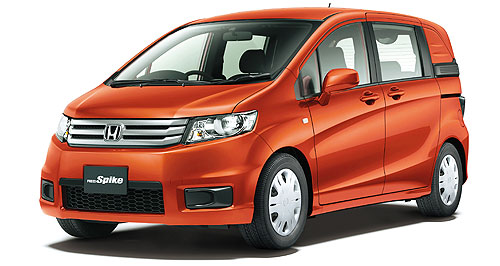Make / Model Search
Future models - Honda - FreedFreed of Civic dutyJazzed up: The Honda Freed mini people-mover is based on the Honda Jazz. Honda Oz contemplates Jazz-based mini people-mover to fill Civic hatch hole18 Aug 2010 HONDA Australia is evaluating a jumped-up Jazz-based five and seven-seater wagon as a versatile entrant to a slot into its range in the absence of a traditional small-car hatchback. That would price the car in question – the Freed (for Freedom) – in the $25,000 to $30,000 bracket … or, in other words, the hunting ground that was once reserved for the Civic hatch when it was being produced in Japan. However, while the Freed was released in Japan during 2008 and then subsequently in Indonesia, Thailand, Singapore and Malaysia, the chance of Honda importing this current, first-generation version into Australia is nigh on negligible. If the Freed gets the green light – and Honda Australia insists that is far from a decision either way – it will most probably be for the Mk2 version that is due to be unveiled in about 2013. The need for Freed has arisen as Honda faces another generational cycle of the Civic from 2012 and up to as long as 2018 without a hatchback version. While a Civic hatch will again be produced in the UK, it will be too expensive to import into Australia in any meaningful numbers to sell alongside the far-cheaper Civic sedan that is made in Thailand. This scenario may change if more sympathetic exchange rates can bring the asking price of the next-gen Civic hatch to substantially under the $38,990 Si hatch that arrived during 2009. Only 420 ended up coming Downunder. Hence, Honda Australia is scouting for a sub-$30,000 small-car alternative to tackle the high-flying Mazda3, Toyota Corolla and Hyundai i30.  Officially, Honda Australia held the brief product walk-through and test drive by journalists of the Freed to demonstrate the ability of its Indonesian manufacturing facility in providing world-standard export-quality vehicles. Officially, Honda Australia held the brief product walk-through and test drive by journalists of the Freed to demonstrate the ability of its Indonesian manufacturing facility in providing world-standard export-quality vehicles.Although manufactured in Japan, the Freed is also produced at Honda’s Karawang facility in Indonesia. That plant may supply Australia (as it already does the Thai market) to keep prices down. The company flew a number of Australian motoring journalists to Thailand to tour its world-class manufacturing facilities that provide Honda Australia with five of its bestselling models – Civic, CR-V, Jazz, Accord and City. Honda Australia CEO Satoshi Matsuzawa told GoAuto that small-car buyers would respond to the Freed’s practicality. Built on a stretched version of the Jazz-based City sedan platform, the Freed shares a strong visual connection with the popular second-generation light-car hatch that made its global debut at the 2007 Tokyo motor show. The 4215/1700/1735mm length/width/height body features cab-forward tallboy mini-MPV styling, twin sliding side doors (that are optionally electrified), a deep tailgate and the option of 2+3 five-seat or three-row six (2+2+2) or seven (2+3+2) seater configurations. The latter would be the most likely starter for Australia. As with the lengthy 2740mm wheelbase, all of the 1280kg Freed’s vitals are substantially greater than the donor Jazz or City. However, as part of the floorplan is derived from the latter light-car sedan, the Jazz’s unique ‘Magic Seats’ that fold down flush into the cavity where a fuel tank normally resides does not exist. Instead the Freed has a deep floor all round, a sliding second-row arrangement, and an old-school 4WD-like side-hinged third-row chairs that lean up against the side of the car when not sat upon. Under the taut, Mercedes-Benz B-class-esque skin is a conventional transverse front-engine mechanical layout. The only engine currently available is a variation of the long-lived 1.5-litre VTEC four-cylinder petrol engine also found in the Jazz and City, delivering 87kW of power at 6600rpm and 146Nm at 4800rpm. It drives the front wheels (or the rears also in the Japan-only 4WD version) via Honda’s Indonesian-built five-speed automatic transmission. If the Freed finds its way to Australia eventually it will almost certainly not feature this engine/transmission combination, since Honda privately acknowledges that a 1.5-litre four-cylinder seven-seater people mover would not appeal to Australian consumers. Larger engines mooted include a 1.8-litre i-VTEC four-cylinder petrol unit, or an example of Honda’s next-generation powerplants and still-secret all-new automatic gearbox. Completing the current Freed specifications are the MacPherson strut front and torsion beam rear suspension set-up, front-wheel discs and rear-wheel drum brakes and a rack and pinion steering system. However, neither of the Thai-market examples we drove around a gated golf course estate was fitted with Honda’s VSA stability control system – though anti-lock brakes and electronic brake-force distribution items were. Drive impressions:TAKE a long, hard look at the Freed and ask yourself: “Would I pay almost $30,000 for this.” If you needed seven seats on a budget, did not care about effortless overtaking or response highway performance, and liked the styling, then we’d imagine the answer would be in the affirmative. Backing that statement would be undeniable Honda quality (it seems the same whether the car is made in Thailand or in the Freed’s case, Japan or Indonesia), a boxy but handsome body, handy side-sliding doors (powered on the models we sampled), a low floor and deep tailgate for easy loading and unloading, sliding second-row seating, a smartly presented dash, and a cabin that majors on roominess and versatility despite being a tad narrower than most small cars. Plus, getting in and out is stupendously easy forward vision is good and all seats represent reasonable comfort – even the really-kids-only third-row pair. Beat that, Mazda3!“Well, OK!” exclaims the Mazda. Step on the accelerator pedal and the familiar Honda engine note summons up a reasonable amount of acceleration even with three adults on board. But put your foot down and the only thing that rises with any conviction is the mechanical howl. No substitute for CCs, see. OK, the spec sheet says ‘1.5L VTEC’ so the Freed won’t exactly thrust forward at neck-snapping speed, but the general sluggishness of the five-speed auto seals this modest drivetrain’s fate. That ought to be enough to have a potential customer pick up a Nissan Dualis +2 brochure ($29,990 with seven seats, stability control, 2.0L and CVT gearbox combo – no contest). There’s a top-heavy and under-tyred feel to the Freed’s chassis behaviour if you corner enthusiastically (lots of understeer and body roll), and an avoidance manoeuvre to miss a large lizard (!) had the Thai-spec Honda lurching like it had an inner-ear infection. We felt the weighty steering seemed a mite disconnected too. Sealing the fate of the disappointing drive was the fact that it felt like a jumped-up Jazz rather than a proper small car. And, anyway, an annoying rattle somewhere in the tailgate, a dashboard that limits knee space of taller people, and the lack of door armrests due to the sliding mechanism, began to dull our enthusiasm for the undeniably accommodating cabin as well. We reckon that – unless a more powerful drivetrain installation and some serious Australian road tuning were to take place – Australians in the market for this configuration of vehicle for under $30K may be curious to check the Freed out, do the sums, drive the car, and move on to either a used seven-seater such as a three-year-old Mitsubishi Grandis, settle for a near-new Kia Carnival, or go the Dualis+2 that’s new. Honda Australia, our advice is to keep looking elsewhere for that elusive five-door small-car hatch alternative.  Read moreAll future models Alfa Romeo Alfa Romeo Abarth Abarth Alpine Alpine Alpina Alpina Audi Audi Aston Martin Aston Martin BMW BMW Bentley Bentley Chery Chery Brabham Brabham Chrysler Chrysler Chevrolet Chevrolet Cupra Cupra Citroen Citroen DS DS Dodge Dodge Fiat Fiat Ferrari Ferrari Foton Foton Ford Ford Great Wall Great Wall FPV FPV Haval Haval GWM GWM Honda Honda Holden Holden Hummer Hummer HSV HSV Infiniti Infiniti Hyundai Hyundai Jaguar Jaguar Isuzu Isuzu Kia Kia Jeep Jeep Land Rover Land Rover Lamborghini Lamborghini Lexus Lexus LDV LDV Mahindra Mahindra Lotus Lotus Mazda Mazda Maserati Maserati Mercedes-AMG Mercedes-AMG McLaren McLaren MG MG Mercedes-Benz Mercedes-Benz Mitsubishi Mitsubishi Mini Mini Opel Opel Nissan Nissan Peugeot Peugeot Pagani Pagani Proton Proton Porsche Porsche Renault Renault Ram Ram Rover Rover Rolls-Royce Rolls-Royce Skoda Skoda Saab Saab SsangYong SsangYong Smart Smart Suzuki Suzuki Subaru Subaru Toyota Toyota Tesla Tesla Volvo VolvoMotor industry news |
Click to shareHonda modelsResearch Honda All future models Alfa Romeo Alfa Romeo Abarth Abarth Alpine Alpine Alpina Alpina Audi Audi Aston Martin Aston Martin BMW BMW Bentley Bentley Chery Chery Brabham Brabham Chrysler Chrysler Chevrolet Chevrolet Cupra Cupra Citroen Citroen DS DS Dodge Dodge Fiat Fiat Ferrari Ferrari Foton Foton Ford Ford Great Wall Great Wall FPV FPV Haval Haval GWM GWM Honda Honda Holden Holden Hummer Hummer HSV HSV Infiniti Infiniti Hyundai Hyundai Jaguar Jaguar Isuzu Isuzu Kia Kia Jeep Jeep Land Rover Land Rover Lamborghini Lamborghini Lexus Lexus LDV LDV Mahindra Mahindra Lotus Lotus Mazda Mazda Maserati Maserati Mercedes-AMG Mercedes-AMG McLaren McLaren MG MG Mercedes-Benz Mercedes-Benz Mitsubishi Mitsubishi Mini Mini Opel Opel Nissan Nissan Peugeot Peugeot Pagani Pagani Proton Proton Porsche Porsche Renault Renault Ram Ram Rover Rover Rolls-Royce Rolls-Royce Skoda Skoda Saab Saab SsangYong SsangYong Smart Smart Suzuki Suzuki Subaru Subaru Toyota Toyota Tesla Tesla Volvo VolvoMotor industry news |










Facebook Twitter Instagram